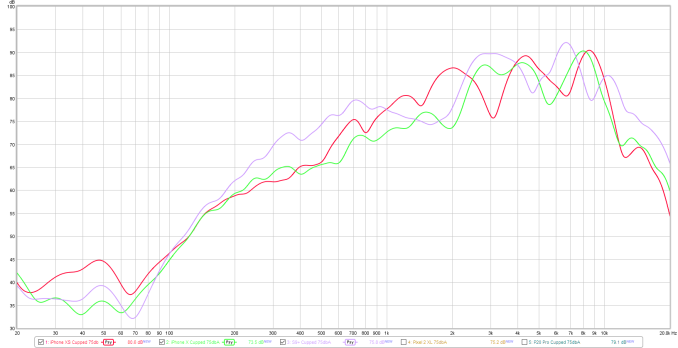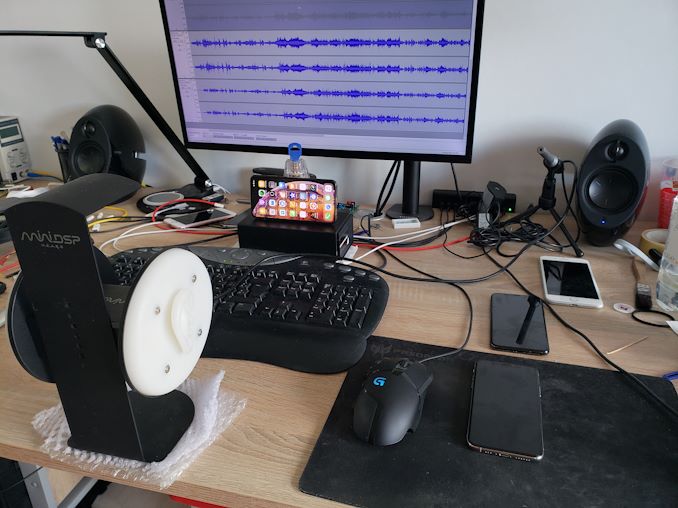The iPhone XS & XS Max Review: Unveiling the Silicon Secrets
by Andrei Frumusanu on October 5, 2018 8:00 AM EST- Posted in
- Mobile
- Apple
- Smartphones
- iPhone XS
- iPhone XS Max
Camera Video Recording
In terms of video recording, the iPhone XS promises an improved dynamic range in modes up to 30fps. What this likely means is that the phone’s able to capture in HDR mode in the 30fps modes, doing the same kind of processing we also see in SmartHDR still pictures.
Also something I’ve dreaded on iPhones for years; the new iPhone XS finally introduces stereo audio recording. Why it took Apple such a long time to finally introduce stereo recording is something that boggles the mind, but, let’s not complain, as we now finally have it on the new generation.
iPhone XS: iPhone X:
Comparing the iPhone XS video to the iPhone X, there’s one thing that is immediately very evident: the new XS is able to produce much better image stabilisation than last year’s flagship. Indeed, it looks like Apple vastly improved the OIS/EIS on the new phones, as the wobble that happens when walking is gone on the XS.
Audio recording finally is up to par, and we can hear the wind and rustling leaves of the trees around us. I think Apple might still have to work a bit on the wind noise cancellation, as in some parts the audio sounded as if it was inside a tube.
In terms of image quality, Apple’s claims of the improved dynamic range are very much verified. The phone showcases a lot more brought down highlights in the scene, and in darker areas, show better shadows. It’s unfortunate that this is limited only to the 30fps modes, but it’s understandable.
Switching over from the main lens to the telephoto lens happens relatively fast, although with a short exposure flash and a slight delay on the first zoom. 4K60 recording doesn’t allow for the use of the telephoto lens.
All in all, the video recording quality of the new iPhone XS is massively improved in all areas of stabilisation, picture quality, and audio. 4K30 recording on the XS is probably the best I’ve seen on any smartphone – a definitive applause to Apple for the improvements here.
Speaker Evaluation
Apple claimed to have improved the speaker audio quality on the new iPhone XS, allowing for more stereo separation and filling sound. I had introduced a new speaker evaluation method a few months ago because this year’s efforts by smartphone vendors to improve speaker quality has been very pronounced, and I wanted to have a way to objectively convey these improvements.
Starting off with speaker loudness, we’re measuring the phones at maximum volume, both in one-hand portrait mode, as well as two-handed mode where the palms are cupped towards the user. These two use-cases are what I find myself most often using the phone’s speakers in, so hopefully that also represents how most users use it as well, please let me know otherwise!

Using a pink noise signal, the iPhone XS pretty much falls into line with the results of the iPhone X, coming in at a very loud 82.8dBA in portrait mode and 87.6dbA in two-handed mode. Apple’s sound directionality on the iPhone X and XS is among the best, most likely due to the fact that the stereo earpiece is among the loudest of current generation smartphones.
Measuring the frequency response of the speakers, we see the iPhone XS closely following the measurement of the iPhone X, however there’s a major difference in the mid-range where the XS is around 5dB louder, raising instrumental frequencies and voices. This difference is what I think Apple is referring to when talking about better “fullness”, as it is evident when playing back media.
To better demonstrate the difference between the phones, I’ve attempted to capture them with a binaural microphone setup. Now I know my environment isn’t perfect as I don’t have the necessary sound dampening equipment, but I hope it does serve as an overall adequate A/B comparison between the phones. I’ve tried to calibrate the sound as much as possible recorded by the setup to a flat frequency response, although I’m sure there are improvements to be made. As a comparison, I also included calibrated speakers as a baseline to get an idea of the microphone setup.
The audio is meant to be listened to with headphones, or even better with IEMs, as this will give the intended playback of the binaural recording.
The iPhone XS’ improvements in the mid-range are quite evident as voices sound deeper and more pronounced on the new phone. Stereo separation is also quite good – resulting in a filling audio experience.
I included the S9+ and G7 as comparison devices. Samsung still does a significantly better job at the low-mid ranges which gives the phone more overall presence than the iPhones, also has an advantage in the very high frequencies giving more clarity, however the new iPhone’s XS strength point in the mid-ranges is the S9’s weakness, and vocals sound a lot less present than on the XS.
As for the G7, I just wanted to showcase a mono speaker device, and just how huge the audio difference is. Unfortunately the G7, even though it promises to have a good speaker, fails in practice.












253 Comments
View All Comments
name99 - Saturday, October 6, 2018 - link
If you're going to count like that, you need to throw in at least 7 Chinook cores (small 64-bit Apple-designed cores that act as controllers for various large blocks like the GPU or NPU).[A Chinook is a type of non-Vortex wind, just like a Zephyr, Tempest, or Mistral...]
There's nothing that screams their existence on the die shots, but what little we know about them has been established by looking at the OS binaries for the new iPhones. Presumably if they really are minimal and require little to no L2 and smaller L1s (ie regular memory structures that are more easily visible), they could look like pretty much any of that vast sea of unexplained territory on the die.
It's unclear what these do today apart from the obvious tasks like initialization and power tracking. (On the GPU it handles thread scheduling.)
Even more interesting is what Apple's long term game here is? To move as much of the OS as possible off the main cores onto these auxiliary cores (and so the wheel of reincarnation spins back to System/360 Channel Controllers?) For example (in principle...) you could run the file system stack on the flash controller, or the network on a controller living near the radio basebands, and have the OS communicate with them at a much more abstract level.
Does this make sense for power, performance, or security reasons? Not a clue! But in a world where transistors are cheap, I'm glad to see Apple slowly rethinking OS and system design decisions that were basically made in the early 1970s, and that we've stuck with ever since then regardless of tech changes.
ex2bot - Sunday, October 7, 2018 - link
Much appreciate the review!s.yu - Monday, October 8, 2018 - link
Great job as always Andrei!I would only have hoped for a more thorough exploration of the limits of the portrait mode, to see if Apple really makes proper use of the depth map, taking a photo in portrait mode in a tunnel to see if the amount of blur is applied according to distance for example.
Mic_whos_right - Tuesday, October 9, 2018 - link
Thanks for this comment--Now I know why nothing last year. Great Anandtech standard of a review! Always above my intellect of understanding w/ info overload that teaches me a lot of the product.Moh Qadee - Thursday, November 1, 2018 - link
Thank you for this great detailed review. I have been coming back to this review before making a purchase. Please make an comparison article of Iphone XS gaming vs other smartphones in market. How much does thermal make difference over longer periods before it starts to throttle or heat up. Would be able to give an approx time before you noticed heat while gaming on XS? I don't mind investing in an expensive phone as long as thermals doesn't limit the performance. There are phones like Razor 2 or Rog out. People make an comparison with an iPhone as it doesn't require much cooling. I wonder if gaming for above 20+ mins makes it challenging for Iphone to heat up enough that you should be worried about?Ahadjisavvas - Monday, November 19, 2018 - link
And the exynos m3 had 12 execution ports right? Can you elaborate on the major differences between the design of the vortex core in the a12 and the meerkat core in the m3? I would deeply appreciate it if you could.Ahadjisavvas - Monday, November 19, 2018 - link
And the exynos m3 has 12 execution ports right? Can you elaborate on the main differences between the design of the exynos m3 and the vortex core,that'll be really helpful and informative as well. Also,are you planning on writing a piece about the a12x soc, it'll be really interesting to hear how far apple has come with the soc on the 2018 ipad pro.alysdexia - Monday, May 13, 2019 - link
"Now what is very interesting here is that this essentially looks identical to Apple’s Swift microarchitecture from Apple's A6 SoC."This comparison doesn't make sense and it seems like you took the same execution ports to determine whether the chips are identical, when the ports could be arbitrary for each release. Rather I took the specifications (feature size, revision) and dates of each from these pages: https://en.wikipedia.org/wiki/Comparison_of_ARMv7-... and https://en.wikipedia.org/wiki/Comparison_of_ARMv8-... to come up with these matches: Cortex-A15-A9 A6, Cortex-A15-A9 A6X, Cortex-A57-A53 A7, Cortex-A57-A53 A8, Cortex-A57-A53 A8X, Cortex-A57-A53 A9, Cortex-A57-A53 A9X, Cortex-A73 A10, Cortex-A73 A10X, Cortex-A75 A11, Cortex-A76 A12, Cortex-A76 A12X. For exemplum 5 execution ports could be gotten (I'm no computer engineer so this is a SWAG.) from the 3 in Cortex-A9 subtracted from the 8 in Cortex-A15 but the later big.LITTLEs with 9 and 5 ports could be split from 7 or 8 as (7+2)+(7−2) or (8+1)+(8−3). You need to correct the Anandtech and Wikipedia pages.
faster -> swifter, swiftlier
ISO -> iso -> idem
's !-> they; 1 != 2
great:small::big:lite::mickel:littel
RSAUser - Friday, October 5, 2018 - link
I still don't like iOS tendency towards warmer photos than it is irl.DERSS - Saturday, October 6, 2018 - link
It is weird because it is warmer in bright light and bleaker in dim light.Why can not they just even it out, make the photos less yellowish in bright light and less bleak in dim light?